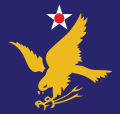| 679th Bombardment Squadron | |
|---|---|
 | |
| Active | 1943-1944 |
| Country | |
| Branch | |
| Role | Heavy bomber |
| Engagements | American Theater of World War II China Burma India Theater |
| Decorations | Distinguished Unit Citation |
| Insignia | |
| Unofficial 679th Bombardment Squadron emblem [1] |  |
The 679th Bombardment Squadron is a disbanded unit of the United States Army Air Forces (AAF). It was last assigned to the 444th Bombardment Group at Dudhkundi Airfield, India where it was disbanded on 12 October 1944.
Contents
- History
- Training for combat
- China Burma India Theater
- Lineage
- Assignments
- Stations
- Aircraft
- Awards and campaigns
- See also
- References
- Notes
- Bibliography
During World War II, the squadron was an Army Air Forces combat organization. It was part of the first Boeing B-29 Superfortress group formed for the 58th Bombardment Wing, and served in the China Burma India Theater as part of Twentieth Air Force. The squadron's aircraft engaged in very heavy bombardment operations against Japan. The squadron received the Distinguished Unit Citation for its combat operations. It was disbanded when the AAF reorganized its very heavy bombardment groups into three squadron units.

